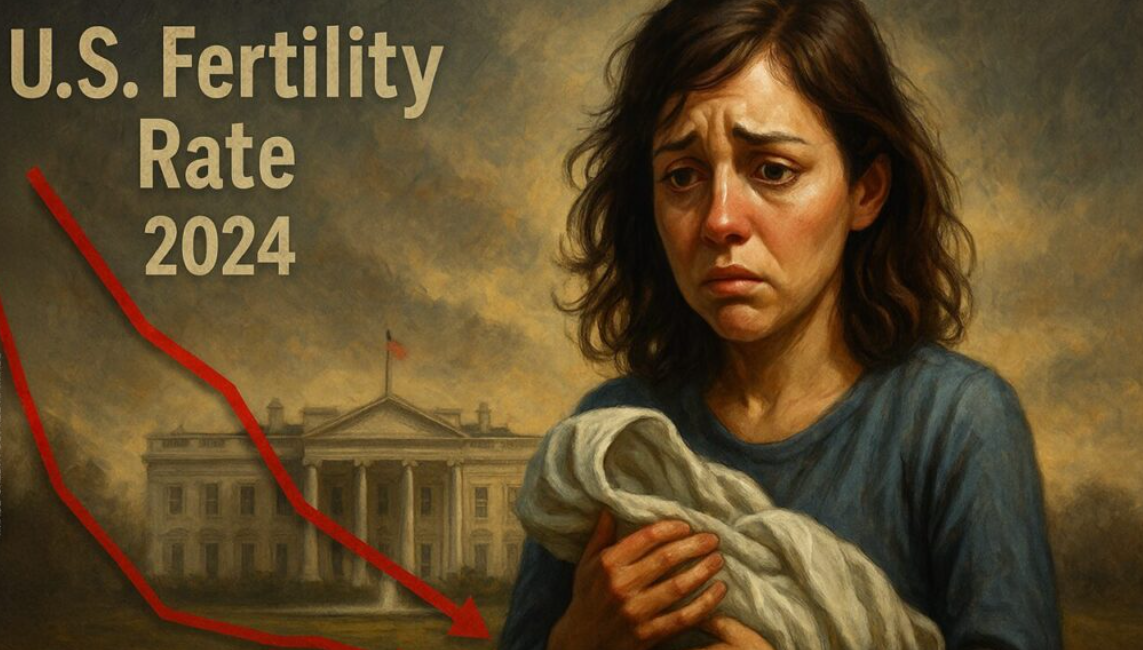NOTE: VIDEO AT THE END OF ARTICLE
A Nation in Decline: CDC Confirms Record-Low Fertility Rate in the U.S.
In a striking new report, the Centers for Disease Control and Prevention (CDC) has confirmed what many feared: the U.S. fertility rate has dropped to its lowest level ever recorded, sliding below 1.6 children per woman in 2024. This figure is far below the 2.1 replacement level necessary to maintain a stable population — and the consequences are profound.
But what exactly is causing this sharp decline? And more importantly, what can be done to reverse it?
Let’s dive into the numbers, the causes, and the controversial plans now being launched to stop America’s demographic freefall.
The Numbers: Below Replacement and Still Dropping
According to the CDC’s National Center for Health Statistics, the total fertility rate (TFR) dropped from 1.621 in 2023 to 1.599 in 2024. While that may sound like a small decrease, it marks the continuation of a 20-year downward trend — and solidifies America’s place among the world’s aging, shrinking nations.
Though the total number of births rose slightly by 1%, this increase was due to statistical population adjustments — not actual improvements in fertility behavior. In other words, the rate is declining even as the population grows due to immigration and census revisions.
Why It’s Happening: A Web of Social and Economic Pressures
So, what’s behind this fertility crash?
The answer is complex, but several key factors stand out:
-
Later marriages and delayed family planning
-
Rising cost of living and housing
-
Student debt and job insecurity
-
Lack of parental leave and affordable childcare
-
Cultural shifts around parenthood and personal fulfillment
As sociologist Karen Guzzo from the University of North Carolina points out, “People are simply not in a place — financially or emotionally — to have children like previous generations.”
🇺🇸 Trump’s Response: Policy Measures to Encourage Parenthood
President Donald J. Trump, now in his second term, has already taken aggressive steps to address the crisis.
Among them:
Executive order to expand access to in vitro fertilization (IVF)
Consideration of direct cash incentives or “baby bonuses”
Promoting family-first tax reforms
National messaging campaigns about the importance of family
Trump recently declared:
“The American family is the cornerstone of a strong nation. We’re going to invest in families again.”
But while the intentions are clear, experts are divided on the impact.
Symbolic or Substantial? Experts Weigh In
Critics argue that these top-down measures, while well-meaning, don’t address the root causes.
“Symbolism won’t lower daycare costs or provide stable housing,” says Guzzo. “We need structural solutions, not slogans.”
In countries like Japan, Italy, and South Korea — all of which have tried financial incentives — birth rates continued to decline unless paired with deep policy reforms like:
-
Universal child care
-
Paid parental leave
-
Flexible work arrangements
-
Affordable housing initiatives
What’s Really at Stake: More Than Numbers
Why does this matter? Because fertility rates shape everything:
-
Workforce size and strength
-
Economic growth potential
-
Social security sustainability
-
National defense readiness
-
Generational balance of power
A declining birth rate doesn’t just mean fewer babies — it means an aging nation, slower innovation, and increasing dependence on immigration and automation to fill the gaps.
What Other Countries Are Doing — And What We Can Learn
Nations around the world have faced similar declines — and responses have varied:
🇭🇺 Hungary offers tax exemptions for mothers of four or more.
🇫🇷 France provides robust child allowances and subsidized daycare.
🇳🇴 Norway offers up to a year of paid parental leave.
🇸🇪 Sweden guarantees job security after childbirth and flexible schedules.
These examples show that reversing a fertility slump requires more than wishful thinking — it demands long-term policy investment, cultural realignment, and economic support.
Conclusion: A Crossroads Moment for American Families
The United States is now standing at a critical turning point.
The CDC’s confirmation of record-low fertility is more than a headline — it’s a wake-up call. If current trends continue, the next generations will face economic stagnation, labor shortages, and even existential questions about the future of American identity.
Whether Trump’s policies will move the needle remains to be seen. But one thing is clear:
Without families, there is no future.
It’s time for a national conversation — not just about babies, but about what kind of society we want to become.

Emily Johnson is a critically acclaimed essayist and novelist known for her thought-provoking works centered on feminism, women’s rights, and modern relationships. Born and raised in Portland, Oregon, Emily grew up with a deep love of books, often spending her afternoons at her local library. She went on to study literature and gender studies at UCLA, where she became deeply involved in activism and began publishing essays in campus journals. Her debut essay collection, Voices Unbound, struck a chord with readers nationwide for its fearless exploration of gender dynamics, identity, and the challenges faced by women in contemporary society. Emily later transitioned into fiction, writing novels that balance compelling storytelling with social commentary. Her protagonists are often strong, multidimensional women navigating love, ambition, and the struggles of everyday life, making her a favorite among readers who crave authentic, relatable narratives. Critics praise her ability to merge personal intimacy with universal themes. Off the page, Emily is an advocate for women in publishing, leading workshops that encourage young female writers to embrace their voices. She lives in Seattle with her partner and two rescue cats, where she continues to write, teach, and inspire a new generation of storytellers.









